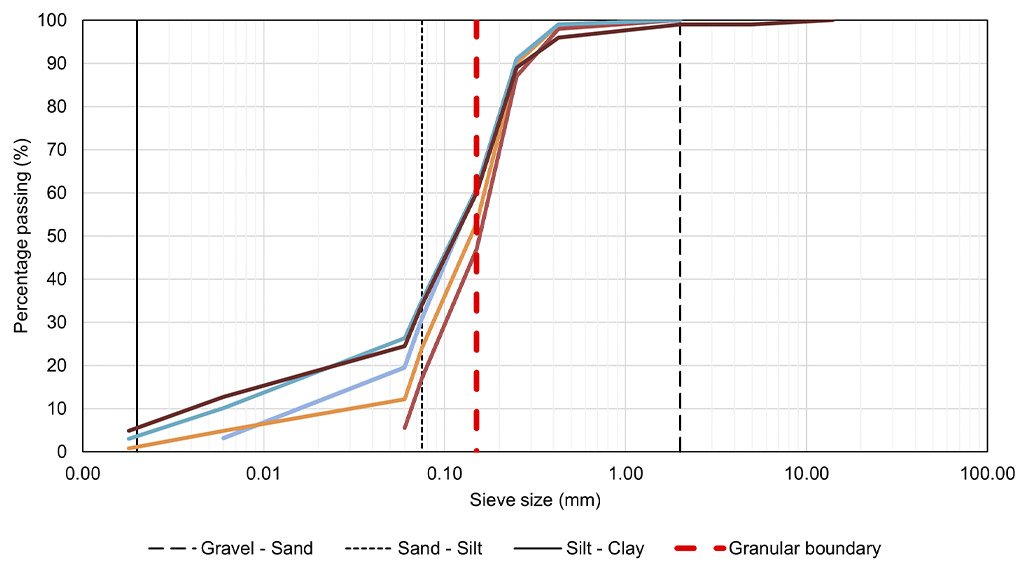
+27 11 441 1111
SRK House, 265 Oxford Road, Illovo, 2196, South Africa

Why project sponsors should be wary of fine-grained sand
When engineers need to improve the in-situ density, the occurrence of very fine-grained sand can present a serious challenge. In fact, developers and contractors need to specifically check for this fine sand as early as possible in a project’s preparation.
This is the view of Brent Cock, principal engineering geologist at SRK Consulting, who has witnessed these conditions on various occasions in his career to date. The grain size that raises the most concern is below 150 microns in diameter – or 0,15 millimetres.
“Proper compaction is a key aspect of ensuring the integrity of geotechnical conditions in road building and other construction activity,” said Cock. “Where there is very fine-grained sand on a project site, the developer needs to identify this early on, and understand the significant implications.”
He explained that the central problem lies in the fact that the particle size falls very close to the boundary of silt-size particles. This is generally 0.075 mm though the British Standard marks the boundary at 0.06 mm. Silt is known to be moisture-sensitive and exhibit potential contractive behaviour (loss of strength under shear) and so, too, fine sands. This is the same process that occurs during compaction which, coupled with a narrow optimum moisture content range, makes the soil extremely difficult to compact.
“Proper compaction is a key aspect of ensuring the integrity of geotechnical conditions in housing projects, road building and other related construction activity,” he said. “Where the soil is present on a project site, the municipality or developer needs to identify this early on to mitigate against and understand the potential implications.”
The early identification of silty, very fine-grained sand needs to include appropriate laboratory tests, over and above proven field tests conducted by an engineering geologist, that will determine the percentage of the problematic grain size within a soil horizon. Professional testing is important, he highlighted, because although the soil often looks and feels like ‘sand’ its behaviour during construction could be quite different.
“Where compaction is attempted, the desired density is typically not achieved often due to inappropriate moisture content. This leads to a potential increase in the soils compressibility. Walking on this surface feels rather like an air mattress – such is its sponginess,” he said. “If you are not aware that this soil type is on your site, it could create considerable extra costs for the project down the line.”
“The presence of a soil horizon with a high percentage of very fine-grained sand is not necessarily a project-stopper, though it will affect a project’s capital requirements,” he said. “At least, if the problem is picked up early, appropriate remedial measures can be incorporated into the engineering design which will feed into the final capital requirements for the project.”
The extra costs could be considerable, he warned. In some cases, it will be necessary to remove this material altogether, and to replace it with something more suitable. Alternatively, it may be possible to rework the material and stabilise it with cement, said Cock. Another option may be to apply a rockfill layer, on which gravel layers can be laid. This is an effective solution if the soils are wet. The most cost-effective option will be determined by the conditions on site.
“Geotechnical assessments would consider the available geological mapping, and may require more intrusive interventions like test pitting or boreholes.”
A professional engineering geologist can undertake a physical on-site inspection, and investigate in more depth with laboratory test results. The value of doing this upfront is difficult to over-estimate, he said, as it can prevent considerable project disruption and delay if fine sand is discovered too late.
Ground movement may even cause cracking that affects the integrity and safety of a building.
“The risks can be mitigated and appropriate engineering solutions derived with a comprehensive site investigation at an early project stage – certainly well before the contractor is deployed to site,” he explained. The value of doing this upfront cannot be overstated, he said, as it can prevent considerable project disruption and delay if this soil type is discovered too late. Structures from homes to roads demand solid ground conditions, he emphasised, and the cost of remediation after project completion can be high, often by orders of magnitude and can cause considerable project delays.
“It is also vital to consider how good geotechnical information on ground conditions can benefit engineering design. The aim being to bring the cost of the project and an optimal engineering design as close as possible,” concluded Cock.
A lack of appropriate geotechnical information at a site can add considerably to the construction cost, as the margin of safety must be higher leading to a more conservative design. With a more detailed and accurate assessment of ground conditions, the engineering design can potentially lead to more cost-effective execution.






